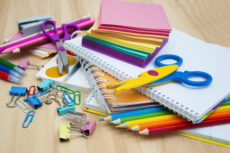$13 Billion in the School Supplies “Poorhouse”
 This summer Tulsa Public Schools third-grade teacher Teresa Danks made national headlines when she decided to panhandle for school supplies. Sick of spending as much as $2,000 of her $35,000 salary each year on the school supplies her classes needed, Danks decided to beg for supplies instead.
This summer Tulsa Public Schools third-grade teacher Teresa Danks made national headlines when she decided to panhandle for school supplies. Sick of spending as much as $2,000 of her $35,000 salary each year on the school supplies her classes needed, Danks decided to beg for supplies instead.
Dubbed the “Panhandling Teacher,” Danks received over $50 in mere minutes begging on the street corner. Danks’ Go Fund Me page has since raised close to $30,000 while donations continue to pour into her school. The response has been so overwhelming that Danks is now helping teachers from other schools fundraise.
But Danks isn’t the only teacher who’s taken extraordinary steps to get ordinary classroom items. According to ABC News’ Katie Kindelan:
Teachers at 76 percent of public schools in America have posted projects on [DonorsChoose.org], and requests worth up to $50 million have been fulfilled in 2017 alone…Of the 900,000 requests from teachers, more than half are for books and basic classroom supplies, according to the website.
Of course, as almost any parent can tell you, school supplies lists these days are anything but “basic.”
In fact, they’re now fodder for parodies like the “The School Supplies List from Hell” published by Parents Magazine, or author Susannah B. Lewis’ exasperated Facebook video equating the cost of buying school supplies for her children with taking out a second mortgage. Actual school supplies lists submitted to Slate Magazine’s Ruth Graham also confirm what she calls “supply inflation,” and they’re no laughing matter:
School-supply lists are now often shockingly long, requesting dozens of specific and sometimes expensive items. They include particular brands: Prang watercolors, Ticonderoga pencils, Elmer’s glue sticks. “Pens” are no longer good enough; only “Black Papermate Flair Porous-Point Medium-Point Pens” will do. And the definition of “school supplies” has expanded to include items like tissues, sanitizing wipes, locker shelves, and plastic baggies.
One fed up grandparent and former public school superintendent successfully sued an Idaho district for charging fees for regular classes and requiring parents and guardians to purchase specific brands of school supplies—basics the district is supposed to be providing (see here and here).
Yet what most teachers and parents don’t realize is just how much funding public school districts already get for supplies.
For perspective, American public elementary and secondary education spending now totals more than $625 billion, according to the U.S Department of Education. (By the way, that’s nearly $130 billion more than the entire Department of Defense budget.)
Of that amount, public schools spend nearly $43 billion on supplies. Once we remove all the supplies spending associated with administration, overhead and maintenance, transportation, food service, instructional staff, student support, and “other” support services, we’re left with over $13 billion in supplies spending associated exclusively with instruction. (For state-level supplies spending, see here.)
This amount works out to around $267 for each of the roughly 50 million elementary and secondary school students. In addition to subsidizing school supplies with their tax dollars, parents pay an additional $300 per child on average for back-to-school supplies, based on costs reported by the Huntington Bank Backpack Index
So the average classroom of 24 students gets around $13,600 for supplies.
What’s more, that $13,600 figure is conservative because it doesn’t include the (exorbitant) extracurricular activities fees parents pay, the additional supplies they donate, or the supplies paid for by teachers, who spend an average of more than $500 each (increasing to over $700 each for teachers in high-poverty schools).
So the next time district officials claim the supply cupboard’s bare, teachers and parents should demand those officials open up the books before opening up their wallets.





